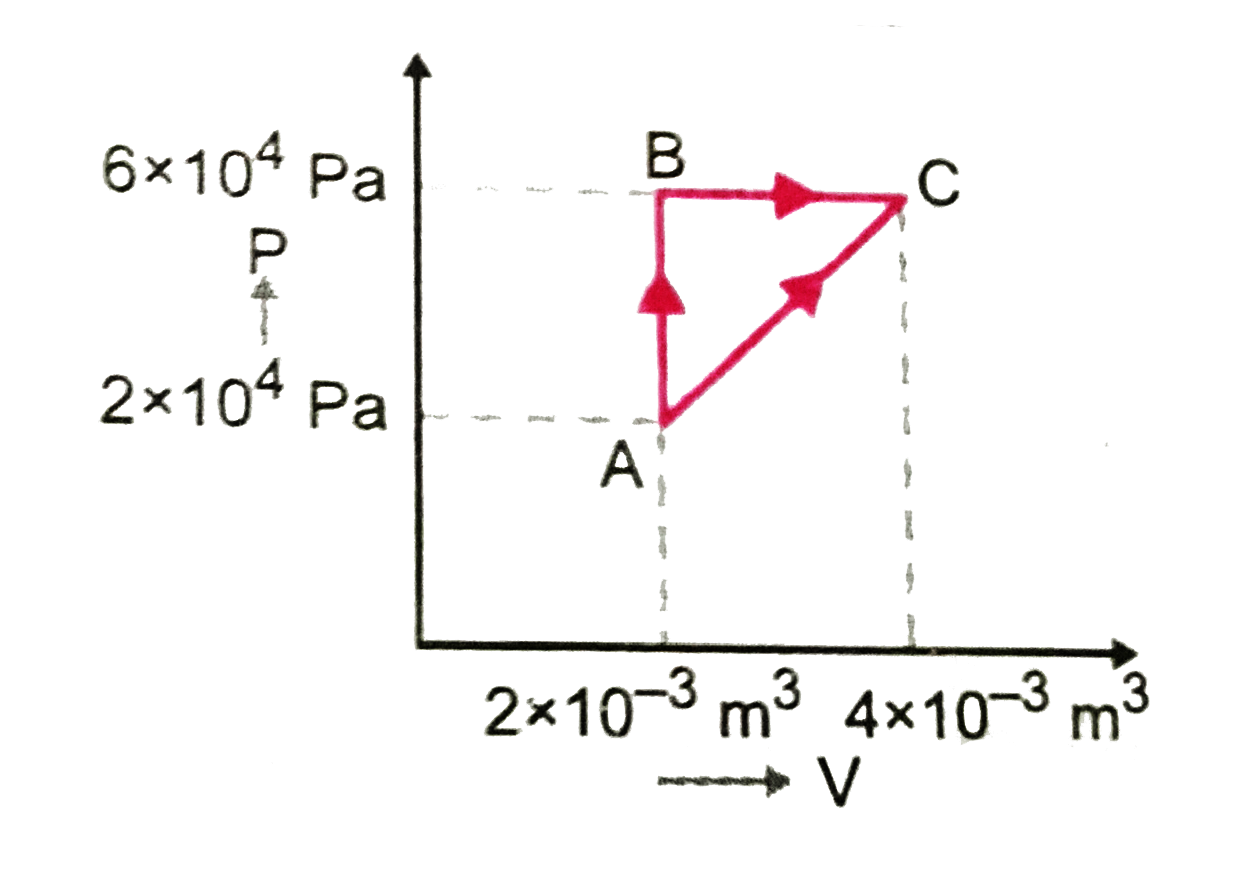A thermodynamic process is shown in figure. In process ab, 600 J of heat is added, and in process bd 200 J of heat is added. The total heat added in process acd is

550 J
650 J
750 J
850 J
The correct Answer is:B
There is no volume change in process ab, so W = 0 Process bd occurs at constant pressure, so the work done by the system is
W=P(V2−V1)=(8×104Pa)(5×10−3m3−2×10−3m3)=240J
Thus the total work for abd is W = 240 J and the total heat for abd is Q = 800 J.
∴ΔU=Q−W=800J−240J=560J
Because ΔU is independent of path, the internal energy change is the same for the path acd as for abd, that is, 560 J. The total work for path acd is
W=(3×104Pa)(5×10−3m3−2×10−3m3)=90J
∴ Total heat added in the path acd is
Q=ΔU+W=560J+90J=650J
Topper's Solved these Questions
- BOOK - MTG GUIDECHAPTER - THERMODYNAMICSEXERCISE - NEET (ITALS)25videos
THERMODYNAMICS
- BOOK - MTG GUIDECHAPTER - THERMODYNAMICSEXERCISE - AIPMT/NEET (MCQs)26videos
THERMODYNAMICS
- BOOK - MTG GUIDECHAPTER - THERMODYNAMICSEXERCISE - AIPMT/NEET (MCQs)26videos
THERMODYNAMICS
- BOOK - MTG GUIDECHAPTER - PROPERTIES OF BULK MATTEREXERCISE - AIPMT/NEET (MCQs)40videos
PROPERTIES OF BULK MATTER
- BOOK - MTG GUIDECHAPTER - WORK, ENERGY AND POWEREXERCISE - AIPMT/NEET (MCQs)34videos
WORK, ENERGY AND POWER
Similar Questions
An ideal diatomic gas undergoes a thermodynamic process as shown in the P−V diagram. The process AB is isochoric while the process BC is isothermal. The total heat gain to the gas in the process is nearly (use ln2=0.7)
 View Solution
View SolutionFigure below shows two paths that may be taken by a gas to go from a state A to a state C . In process AB , 400 J of heat is added to the system and in process BC , 100 J of heat is added to the system . The heat absorbed by the system in the process AC will be
 View Solution
View Solution
Knowledge Check
- Question 1 - Select One
A thermodynamic process is shown in the following figure. In the process AB, 600 J of heat is added to the system and in BC, 200 J of heat is added to the system. The change in internal energy of the system in the process AC would be:
PA=3×104Pa,VA=2×10−3m3
PB=8×104Pa,VC=5×10−3m3
 A560JB800JC600JD640J
A560JB800JC600JD640J - Question 2 - Select One
In (figure). shows two path that may be taken by a gas to go from a state A to state C

In the process AB, 400J of heat is added to the system and in process Bc, 100J of heat is added to the system. The heat absorbed by the system in the process AC will beA500JB460JC300JD380J - Question 3 - Select One
Figure below shows two paths that may be taken by a gas to go from a state A to a state C. In process AB, 400 J of heat is added to the system and in process BC, 100 J of heat is added to the system. The heat absorbed by the system in the process AC will be
 A500 JB460 JC300 JD380 J
A500 JB460 JC300 JD380 J
An ideal diatomic gas undergoes a thermodynamic process as shown in the P−V diagram. The process AB is isochoric while the process BC is isothermal. The total heat gein to the gas in the process is nearly (use ln2=0.7)
 View Solution
View SolutionIn (figure). shows two path that may be taken by a gas to go from a state A to state C

In the process AB, 400J of heat is added to the system and in process Bc, 100J of heat is added to the system. The heat absorbed by the system in the process AC will beView SolutionFigure below shows two paths that may be taken by a gas to go from state A to a state C. In process AB, 400 Jof heat is added to the system and in proces BC, 100 J of heat is added to the system. The heat absorbed by the system in the process AC will be
 View Solution
View SolutionA thermodynamic process is shown in this figure. The pressure and volumes corresponding to some points in the figure are

PA=3×104Pa VA=2×103m3
PB=8×104Pa, VD=5×10−3m3
In process AB, 600 J of heat is added to the system and in process BC 200 J of heat is added to the system. The change in internal energy of the system in process AC would beView SolutionA thermodynamic process is shown in Fig. The pressures and volumes corresponding to some points in the figure are : PA=3×104Pa,PB=8×104Pa and VA=2×10−3m3,VD=5×10−3m.
In process AB,600J of heat is added to the system and in process BC,200J of heat is added to the system. The change in internal energy of the energy of the process AC would be.
 View Solution
View Solution
